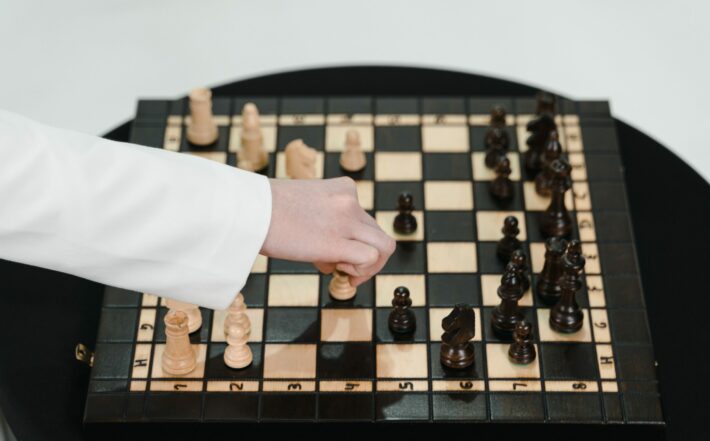The Queen’s Gambit stands as a shining testament to the strategic brilliance of chess’s dynamic opening moves. A captivating and age-old gambit, it continues to intrigue and challenge players at all levels.
By sacrificing a pawn in exchange for central control and dynamic piece play, the Queen’s Gambit sets the stage for engrossing battles on the board. In this exploration, we delve into the historical significance, key principles, and tactical complexities that make the Queen’s Gambit a revered cornerstone of chess theory.
How does the Queen’s Gambit impact the early game of chess?
The Queen’s Gambit has a significant impact on the early stages of a chess game, shaping the dynamics and strategies that follow. By sacrificing a pawn in exchange for central control, the player initiating the Queen’s Gambit aims to establish a strong presence on the board.
This opening move fosters a tactical environment where players must carefully navigate the ensuing positions, considering pawn structures, piece development, and potential counterplay. The Queen’s Gambit injects excitement into the early game, offering both opportunities and challenges that set the tone for the rest of the match.
What are the key principles behind the Queen’s Gambit strategy?

The Queen’s Gambit strategy revolves around key principles that guide players who employ this opening. First and foremost is the objective of seizing control over the central squares, d4, and d5, through pawn sacrifice. This grants the player increased influence in the game and facilitates the development of their pieces.
Another principle is maintaining a flexible pawn structure, allowing for adaptability in response to the opponent’s moves. Additionally, piece activity, coordination, and strategic maneuvering are crucial aspects of the Queen’s Gambit strategy, enabling players to create threats and exploit weaknesses.
How does the Queen’s Gambit differ from other opening moves in chess?
The Queen’s Gambit stands out from other opening moves in chess due to its unique pawn sacrifice and emphasis on central control. Unlike more conservative openings, the Queen’s Gambit involves willingly relinquishing a pawn to gain a positional advantage.
This aggressive approach challenges opponents to make critical decisions early on, affecting the subsequent flow of the game. Additionally, the Queen’s Gambit often leads to complex positions with rich tactical opportunities, setting it apart from the more straightforward and predictable opening moves commonly seen in chess.
What are the advantages and disadvantages of playing the Queen’s Gambit?
Playing the Queen’s Gambit offers distinct advantages and disadvantages that players must carefully consider. One advantage is the opportunity to seize control of the center, dictating the pace and direction of the game.
The Queen’s Gambit also opens avenues for dynamic piece play and tactical combinations. However, the main disadvantage is the risk associated with sacrificing a pawn, potentially exposing weaknesses that can be exploited by the opponent. Additionally, if not executed with precision, the Queen’s Gambit can result in a compromised pawn structure or a disadvantageous position.
How can the Queen’s Gambit influence the middle game in chess?
The influence of the Queen’s Gambit extends into the middle game, shaping the subsequent strategic and tactical decisions. The central control obtained from the initial pawn sacrifice lays the groundwork for future maneuvers, allowing players to develop their pieces harmoniously and prepare for potential attacks.
Moreover, the unique pawn structure that emerges from the Queen’s Gambit creates specific plans and pawn breaks, influencing the flow of the game. It often sets the stage for intricate tactical battles, as players seek to exploit weaknesses or create advantageous positions to outmaneuver their opponents.
What are the main variations and lines within the Queen’s Gambit?
The Queen’s Gambit encompasses several main variations and lines that offer diverse paths for players to explore. One prominent variation is the Accepted Queen’s Gambit, where Black captures the offered pawn.
This can lead to positional struggles and tactical complications. Another popular line is the Declined Queen’s Gambit, where Black declines the pawn and seeks to maintain a solid defense. Within these variations, further sub-lines and transpositions arise, offering a vast array of possibilities and strategic choices for players adopting the Queen’s Gambit.
How does the Queen’s Gambit impact positional play in chess?
The Queen’s Gambit has a profound impact on positional play in chess, emphasizing key positional elements. By sacrificing a pawn to gain central control, players employing the Queen’s Gambit aim to establish a strong pawn structure and maximize piece activity.
This opening often leads to closed or semi-closed positions, where strategic maneuvering and pawn structure management become critical. Players must carefully assess piece placement, control over key squares, and the development of long-term plans, as these factors heavily influence the outcome of the game.
What are the key ideas and concepts behind the Queen’s Gambit opening?
The Queen’s Gambit is built upon several key ideas and concepts that players must grasp to utilize this opening effectively. One central concept is the importance of pawn control in the center of the board, enabling piece mobility and strategic flexibility.
Another key idea is the potential for sacrificing material to gain an advantage in position or initiative. Understanding the interplay between piece development, pawn structure, and tactical opportunities is crucial for successfully implementing the Queen’s Gambit and capitalizing on its inherent complexities.
How can players effectively counter the Queen’s Gambit in chess?
Effectively countering the Queen’s Gambit requires careful planning and strategic decision-making. One approach is to decline the gambit and focus on solid defense, aiming to undermine the opponent’s central control while maintaining a stable pawn structure.
Another counterstrategy is to accept the gambit but promptly return the pawn to relieve the opponent’s pressure. Additionally, challenging the opponent’s piece coordination, exploiting weak squares, and engaging in tactical skirmishes can disrupt the harmony of the Queen’s Gambit, allowing counterattacking opportunities and a chance to seize the initiative.
What are the common mistakes to avoid when playing the Queen’s Gambit?
When playing the Queen’s Gambit, players should be mindful of common mistakes that can undermine their position. One mistake is overextending and neglecting piece development in favor of aggressive pawn advances. This can lead to exposed pieces and tactical vulnerabilities.
Another error is failing to anticipate counterattacks from the opponent, underestimating their potential threats. Furthermore, neglecting proper pawn structure management and overlooking positional considerations can leave players in a compromised position. By avoiding these mistakes, players can maximize the potential of the Queen’s Gambit and mitigate risks.
How does the Queen’s Gambit contribute to tactical opportunities in chess?
The Queen’s Gambit sets the stage for numerous tactical opportunities in chess. The initial pawn sacrifice creates imbalances and opens up possibilities for tactical strikes. Players often seek to exploit weak squares, unleash discovered attacks, or initiate combinations involving the exposed opponent’s king.
The unique pawn structures arising from the Queen’s Gambit create favorable conditions for tactical motifs such as pins, skewers, and back-rank vulnerabilities. Astute calculation, pattern recognition, and the ability to seize tactical opportunities are essential skills when playing the Queen’s Gambit.
Below is a table that shows the Tactical Opportunities in The Queen’s Gambit:
| Types of Tactical Opportunities | Description | Example |
|---|---|---|
| Queen Sacrifice | Strategically sacrificing the queen to gain a tactical advantage or force mate. | In a critical position, sacrificing the queen with Qxh7+ leads to checkmate. |
| Pawn Breaks | Utilizing pawn moves to open up lines, create threats, or gain material. | Advancing the d-pawn to d5 breaks the opponent’s pawn structure and opens up lines for piece activity. |
| Pinning Tactics | Using a piece to immobilize the opponent’s piece, makes it vulnerable to capture or exploitation. | Pinning the opponent’s knight to their king with Bb5 creates tactical threats and restricts their options. |
| Discovered Attacks | Unleashing the power of another piece by moving one piece out of the way, creates a double threat. | Moving a bishop to reveal an attack from a rook behind it, simultaneously targeting two pieces. |
| Back-Rank Vulnerabilities | Exploiting weaknesses in the opponent’s back rank to launch tactical attacks or gain material. | A tactical combination involving a rook lift to the opponent’s back rank, leading to a decisive advantage. |
What are the main objectives and goals of playing the Queen’s Gambit?

The main objectives of playing the Queen’s Gambit are to establish central control, create imbalances, and gain a strategic advantage. By sacrificing a pawn, players aim to control the critical d4 and d5 squares, limiting the opponent’s options and dictating the course of the game.
Additionally, the Queen’s Gambit seeks to disrupt the opponent’s pawn structure, potentially leading to weaknesses that can be exploited later. The overarching goal is to set the stage for dynamic piece play, tactical opportunities, and long-term strategic plans, putting pressure on the opponent and increasing the chances of a successful outcome.
How does the Queen’s Gambit impact the overall strategic balance of a game?
The Queen’s Gambit has a significant impact on the overall strategic balance of a game. By sacrificing a pawn, it introduces an imbalance in material and position, shifting the strategic landscape. Players who employ the Queen’s Gambit seek to leverage this imbalance to their advantage by gaining central control, developing pieces actively, and creating potential weaknesses in the opponent’s camp.
The strategic balance is influenced by factors such as pawn structure, piece coordination, king safety, and control of critical squares. Adapting to and exploiting the resulting strategic imbalances is key to success in games involving the Queen’s Gambit.
What are the key principles of defense against the Queen’s Gambit?
Defending against the Queen’s Gambit requires adherence to key defensive principles. Firstly, maintaining a solid pawn structure and avoiding unnecessary weaknesses is crucial. Players should strive to counter the opponent’s central control while ensuring the safety of their pieces and king.
Secondly, active piece development is essential to establish counterplay and challenge the opponent’s initiative. By coordinating pieces effectively and controlling critical squares, defenders can neutralize the opponent’s advantages and seize tactical opportunities. Lastly, accurate calculation, prophylactic thinking, and precise move selection are vital in defending against the dynamic threats posed by the Queen’s Gambit.
How can players effectively exploit the weaknesses caused by the Queen’s Gambit?
Effectively exploiting weaknesses caused by the Queen’s Gambit demands astute positional understanding and tactical awareness. Identifying vulnerable squares and weak pawn structures created by the gambit is crucial. Players can then strategically maneuver their pieces to exploit these weaknesses, placing increased pressure on the opponent’s position.
Attacking the exposed king, undermining weak pawns, and targeting poorly defended squares are effective strategies. Moreover, coordinating piece activity, utilizing tactical motifs, and applying strategic pressure in the right moments are key to capitalizing on the weaknesses generated by the Queen’s Gambit.
What are the different variations and systems within the Queen’s Gambit?
The Queen’s Gambit encompasses various variations and systems that players can choose from based on their preferred style and strategic inclinations. Some notable variations include the Orthodox Variation, the Tarrasch Defense, and the Cambridge Springs Variation.
Each variation presents unique positional and tactical characteristics, providing players with diverse options to navigate the complexities of the Queen’s Gambit. By studying and understanding the different systems, players can tailor their approach, exploit specific weaknesses, and surprise opponents with their chosen variation.
How does the Queen’s Gambit impact pawn structure and dynamics?

The Queen’s Gambit exerts a significant influence on pawn structure and dynamics. The initial pawn sacrifice disrupts the opponent’s pawn formation, creating imbalances and vulnerabilities. Players must carefully manage their pawn structure, considering the advantages and disadvantages that arise from the Queen’s Gambit.
This includes deciding when to advance or exchange pawns, evaluating pawn breaks to open up lines for piece activity, and understanding the long-term implications of pawn structure decisions. Skillful pawn structure management allows players to leverage the dynamics of the Queen’s Gambit and exploit positional advantages.
Ultimately
The Queen’s Gambit remains an iconic and influential opening move, celebrated for its strategic depth and tactical opportunities. Its ability to create imbalances, impact pawn structures, and shape the course of the game ensures its enduring allure in both casual matches and high-stakes tournaments.
As players continue to study and unravel the intricacies of the Queen’s Gambit, its strategic brilliance will undoubtedly inspire generations of chess enthusiasts and continue to leave a lasting mark on the world of competitive chess.




